Sarah Tymochko
The Impact of Changes in Resolution on the Persistent Homology of Images
Nov 10, 2021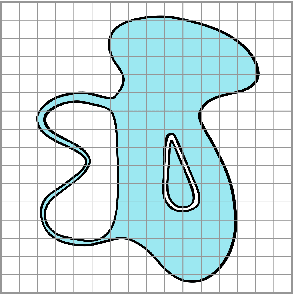
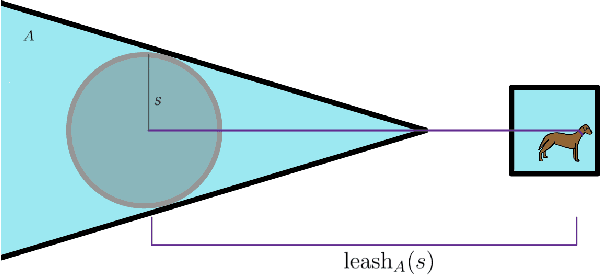
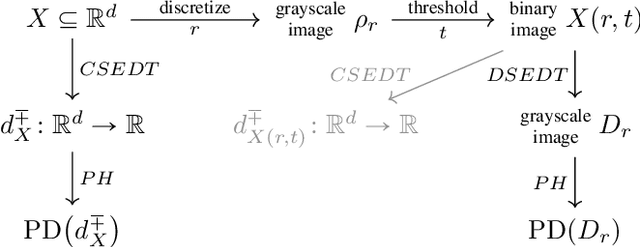
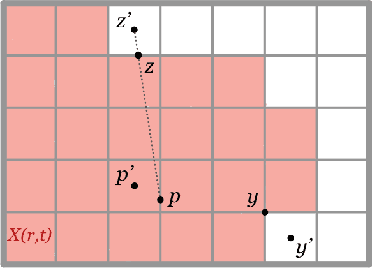
Abstract:Digital images enable quantitative analysis of material properties at micro and macro length scales, but choosing an appropriate resolution when acquiring the image is challenging. A high resolution means longer image acquisition and larger data requirements for a given sample, but if the resolution is too low, significant information may be lost. This paper studies the impact of changes in resolution on persistent homology, a tool from topological data analysis that provides a signature of structure in an image across all length scales. Given prior information about a function, the geometry of an object, or its density distribution at a given resolution, we provide methods to select the coarsest resolution yielding results within an acceptable tolerance. We present numerical case studies for an illustrative synthetic example and samples from porous materials where the theoretical bounds are unknown.
A Topological Approach for Motion Track Discrimination
Feb 10, 2021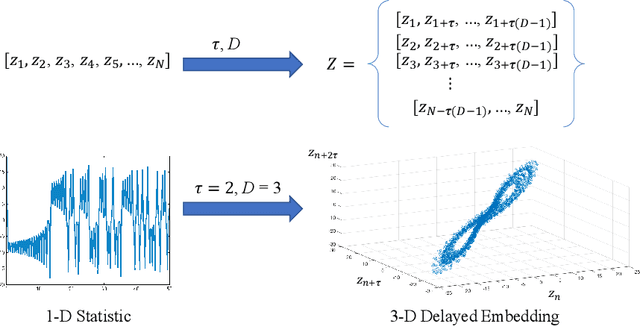
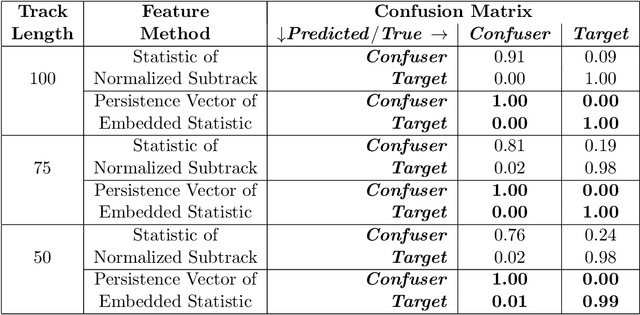
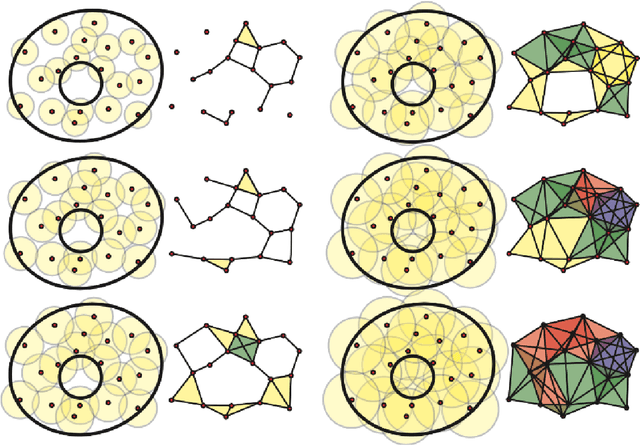
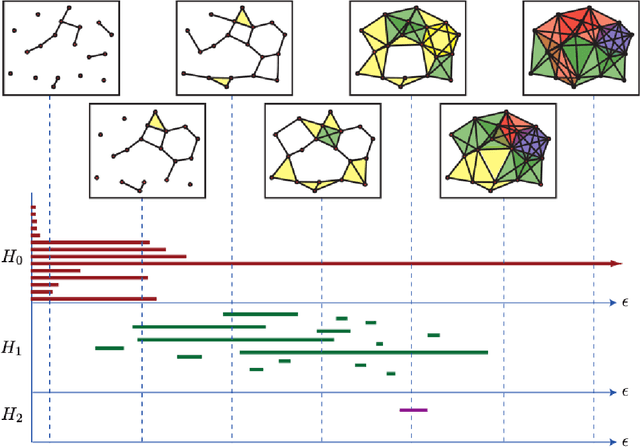
Abstract:Detecting small targets at range is difficult because there is not enough spatial information present in an image sub-region containing the target to use correlation-based methods to differentiate it from dynamic confusers present in the scene. Moreover, this lack of spatial information also disqualifies the use of most state-of-the-art deep learning image-based classifiers. Here, we use characteristics of target tracks extracted from video sequences as data from which to derive distinguishing topological features that help robustly differentiate targets of interest from confusers. In particular, we calculate persistent homology from time-delayed embeddings of dynamic statistics calculated from motion tracks extracted from a wide field-of-view video stream. In short, we use topological methods to extract features related to target motion dynamics that are useful for classification and disambiguation and show that small targets can be detected at range with high probability.
Argumentative Topology: Finding Loop(holes) in Logic
Nov 17, 2020
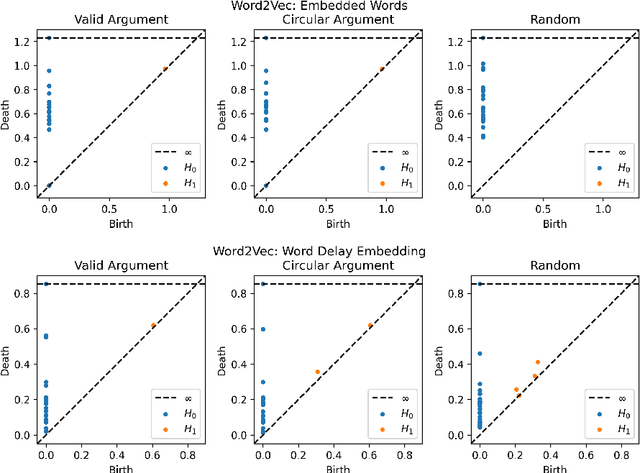
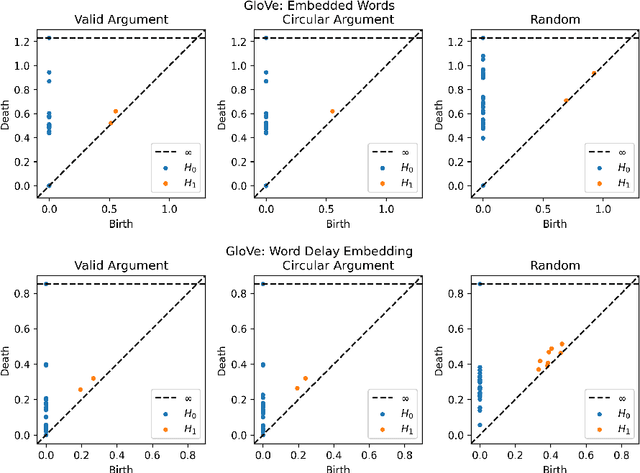
Abstract:Advances in natural language processing have resulted in increased capabilities with respect to multiple tasks. One of the possible causes of the observed performance gains is the introduction of increasingly sophisticated text representations. While many of the new word embedding techniques can be shown to capture particular notions of sentiment or associative structures, we explore the ability of two different word embeddings to uncover or capture the notion of logical shape in text. To this end we present a novel framework that we call Topological Word Embeddings which leverages mathematical techniques in dynamical system analysis and data driven shape extraction (i.e. topological data analysis). In this preliminary work we show that using a topological delay embedding we are able to capture and extract a different, shape-based notion of logic aimed at answering the question "Can we find a circle in a circular argument?"
Chatter Diagnosis in Milling Using Supervised Learning and Topological Features Vector
Oct 27, 2019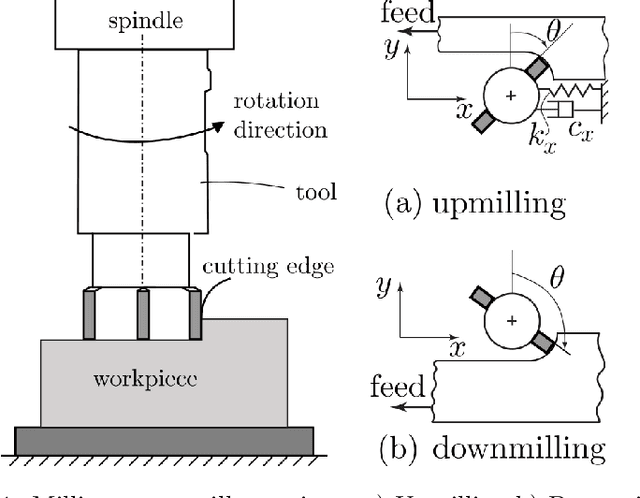

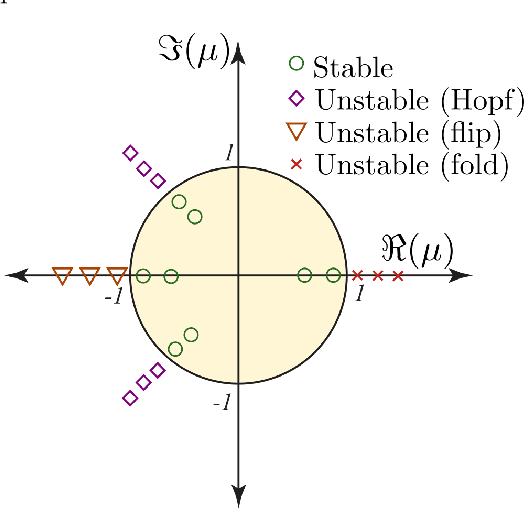
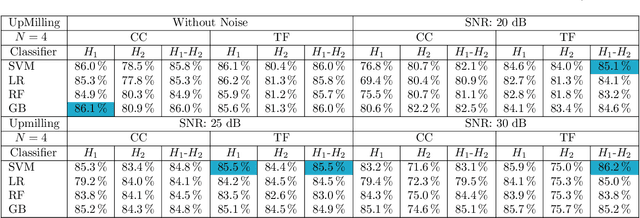
Abstract:Chatter detection has become a prominent subject of interest due to its effect on cutting tool life, surface finish and spindle of machine tool. Most of the existing methods in chatter detection literature are based on signal processing and signal decomposition. In this study, we use topological features of data simulating cutting tool vibrations, combined with four supervised machine learning algorithms to diagnose chatter in the milling process. Persistence diagrams, a method of representing topological features, are not easily used in the context of machine learning, so they must be transformed into a form that is more amenable. Specifically, we will focus on two different methods for featurizing persistence diagrams, Carlsson coordinates and template functions. In this paper, we provide classification results for simulated data from various cutting configurations, including upmilling and downmilling, in addition to the same data with some added noise. Our results show that Carlsson Coordinates and Template Functions yield accuracies as high as 96% and 95%, respectively. We also provide evidence that these topological methods are noise robust descriptors for chatter detection.
Adaptive Partitioning for Template Functions on Persistence Diagrams
Oct 18, 2019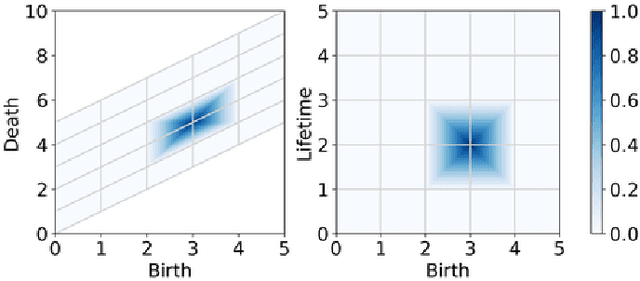
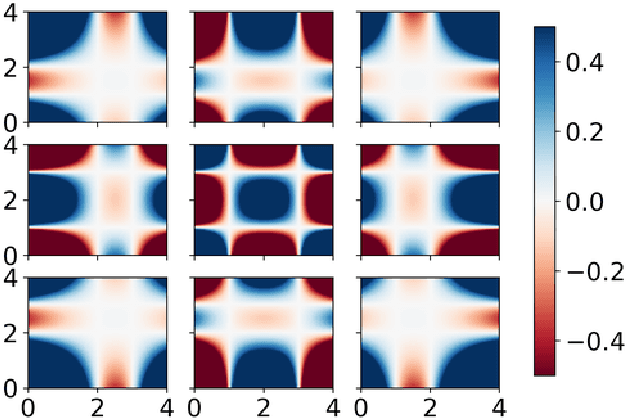
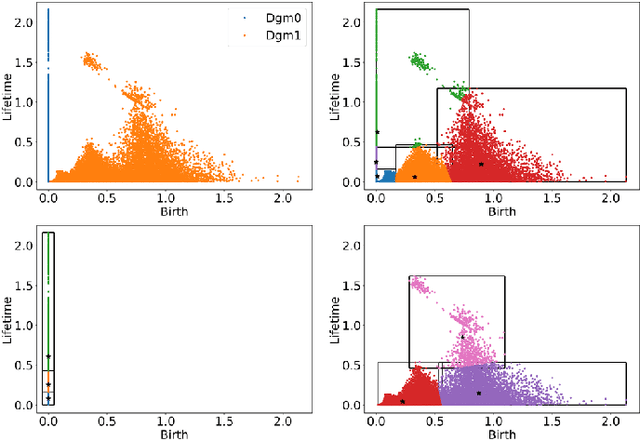
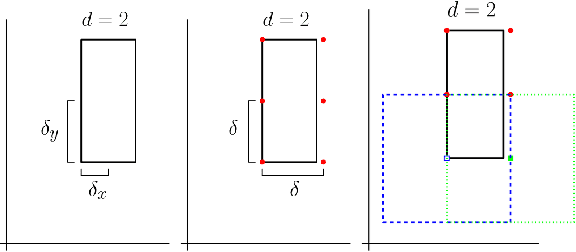
Abstract:As the field of Topological Data Analysis continues to show success in theory and in applications, there has been increasing interest in using tools from this field with methods for machine learning. Using persistent homology, specifically persistence diagrams, as inputs to machine learning techniques requires some mathematical creativity. The space of persistence diagrams does not have the desirable properties for machine learning, thus methods such as kernel methods and vectorization methods have been developed. One such featurization of persistence diagrams by Perea, Munch and Khasawneh uses continuous, compactly supported functions, referred to as "template functions," which results in a stable vector representation of the persistence diagram. In this paper, we provide a method of adaptively partitioning persistence diagrams to improve these featurizations based on localized information in the diagrams. Additionally, we provide a framework to adaptively select parameters required for the template functions in order to best utilize the partitioning method. We present results for application to example data sets comparing classification results between template function featurizations with and without partitioning, in addition to other methods from the literature.
Using Persistent Homology to Quantify a Diurnal Cycle in Hurricane Felix
Feb 17, 2019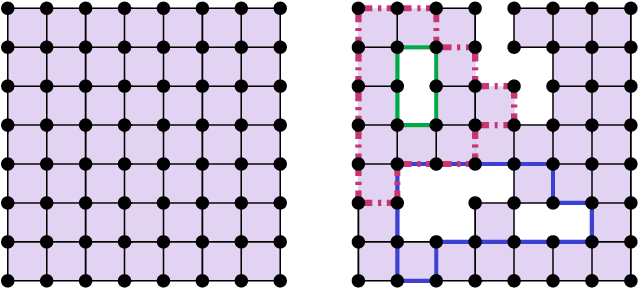
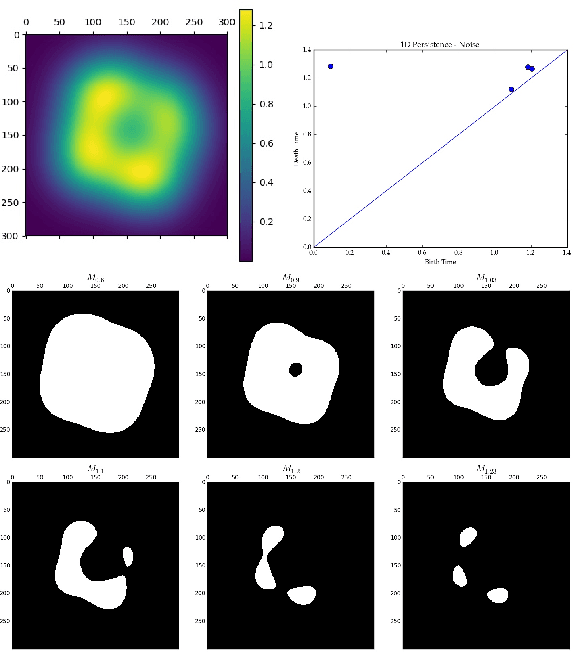
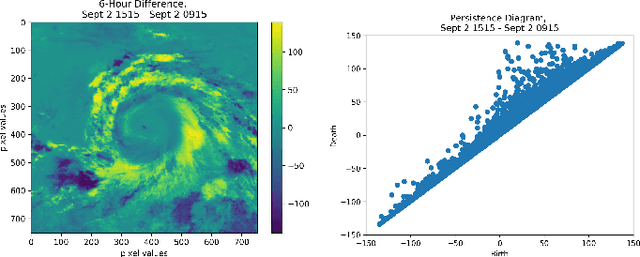
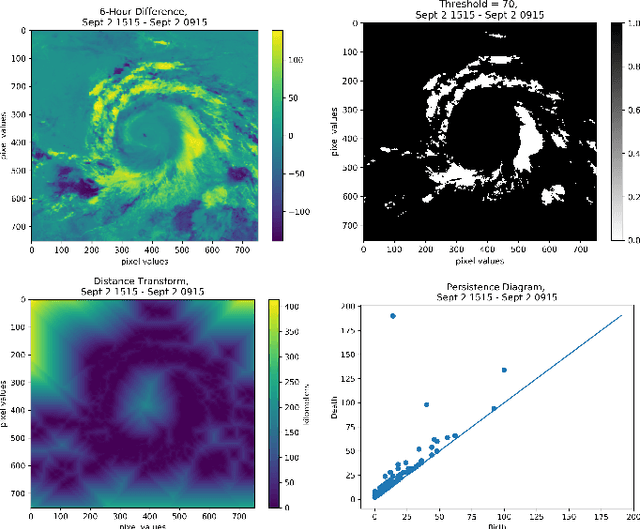
Abstract:The diurnal cycle of tropical cyclones (TCs) is a daily cycle in clouds that appears in satellite images and may have implications for TC structure and intensity. The diurnal pattern can be seen in infrared (IR) satellite imagery as cyclical pulses in the cloud field that propagate radially outward from the center of nearly all Atlantic-basin TCs. These diurnal pulses, a distinguishing characteristic of the TC diurnal cycle, begin forming in the storm's inner core near sunset each day and appear as a region of cooling cloud-top temperatures. The area of cooling takes on a ring-like appearance as cloud-top warming occurs on its inside edge and the cooling moves away from the storm overnight, reaching several hundred kilometers from the circulation center by the following afternoon. The state-of-the-art TC diurnal cycle measurement has a limited ability to analyze the behavior beyond qualitative observations. We present a method for quantifying the TC diurnal cycle using one-dimensional persistent homology, a tool from Topological Data Analysis, by tracking maximum persistence and quantifying the cycle using the discrete Fourier transform. Using Geostationary Operational Environmental Satellite IR imagery data from Hurricane Felix (2007), our method is able to detect an approximate daily cycle.
 Add to Chrome
Add to Chrome Add to Firefox
Add to Firefox Add to Edge
Add to Edge